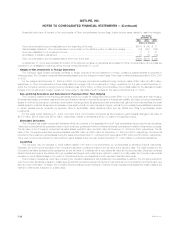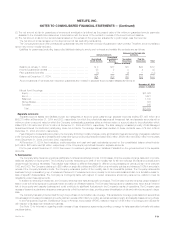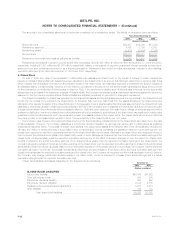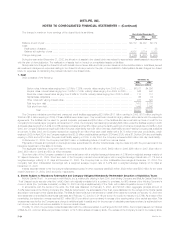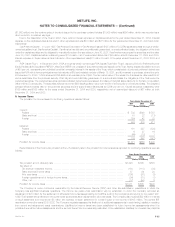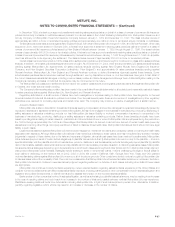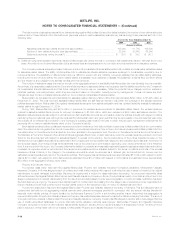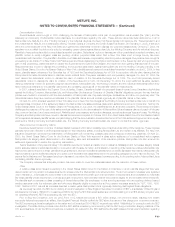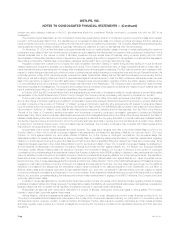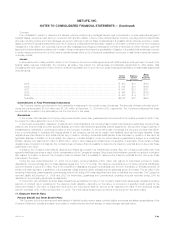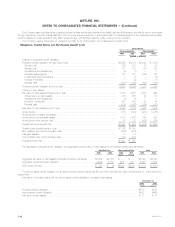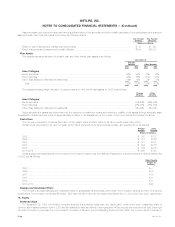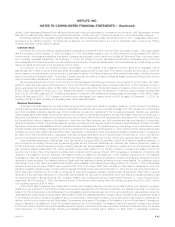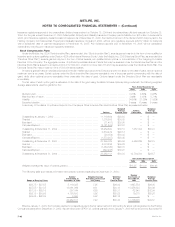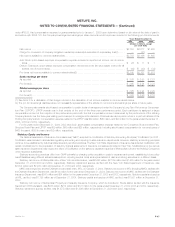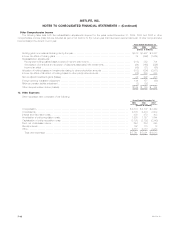MetLife 2004 Annual Report Download - page 81
Download and view the complete annual report
Please find page 81 of the 2004 MetLife annual report below. You can navigate through the pages in the report by either clicking on the pages listed below, or by using the keyword search tool below to find specific information within the annual report.
METLIFE, INC.
NOTES TO CONSOLIDATED FINANCIAL STATEMENTS — (Continued)
The total number of asbestos personal injury claims pending against Metropolitan Life as of the dates indicated, the number of new claims during the
years ended on those dates and the total settlement payments made to resolve asbestos personal injury claims during those years are set forth in the
following table:
At or for the Years Ended December 31,
2004 2003 2002
(Dollars in millions)
Asbestos personal injury claims at year end (approximate) *************************** 108,000 111,700 106,500
Number of new claims during the year (approximate) ******************************* 23,500 58,650 66,000
Settlement payments during the year(1) ****************************************** $ 85.5 $ 84.2 $ 95.1
(1) Settlement payments represent payments made by Metropolitan Life during the year in connection with settlements made in that year and in prior
years. Amounts do not include Metropolitan Life’s attorneys’ fees and expenses and do not reflect amounts received from insurance carriers.
The Company believes adequate provision has been made in its consolidated financial statements for all probable and reasonably estimable losses
for asbestos-related claims. The ability of Metropolitan Life to estimate its ultimate asbestos exposure is subject to considerable uncertainty due to
numerous factors. The availability of data is limited and it is difficult to predict with any certainty numerous variables that can affect liability estimates,
including the number of future claims, the cost to resolve claims, the disease mix and severity of disease, the jurisdiction of claims filed, tort reform efforts
and the impact of any possible future adverse verdicts and their amounts.
The number of asbestos cases that may be brought or the aggregate amount of any liability that Metropolitan Life may ultimately incur is uncertain.
Accordingly, it is reasonably possible that the Company’s total exposure to asbestos claims may be greater than the liability recorded by the Company in
its consolidated financial statements and that future charges to income may be necessary. While the potential future charges could be material in
particular quarterly or annual periods in which they are recorded, based on information currently known by management, it does not believe any such
charges are likely to have a material adverse effect on the Company’s consolidated financial position.
Metropolitan Life increased its recorded liability for asbestos-related claims by $402 million from approximately $820 million to $1,225 million at
December 31, 2002. This total recorded asbestos-related liability (after the self-insured retention) was within the coverage of the excess insurance
policies discussed below. Metropolitan Life regularly reevaluates its exposure from asbestos litigation and has updated its liability analysis for asbestos-
related claims through December 31, 2004.
During 1998, Metropolitan Life paid $878 million in premiums for excess insurance policies for asbestos-related claims. The excess insurance
policies for asbestos-related claims provide for recovery of losses up to $1,500 million, which is in excess of a $400 million self-insured retention. The
asbestos-related policies are also subject to annual and per-claim sublimits. Amounts are recoverable under the policies annually with respect to claims
paid during the prior calendar year. Although amounts paid by Metropolitan Life in any given year that may be recoverable in the next calendar year under
the policies will be reflected as a reduction in the Company’s operating cash flows for the year in which they are paid, management believes that the
payments will not have a material adverse effect on the Company’s liquidity.
Each asbestos-related policy contains an experience fund and a reference fund that provides for payments to Metropolitan Life at the commutation
date if the reference fund is greater than zero at commutation or pro rata reductions from time to time in the loss reimbursements to Metropolitan Life if the
cumulative return on the reference fund is less than the return specified in the experience fund. The return in the reference fund is tied to performance of
the Standard & Poor’s 500 Index and the Lehman Brothers Aggregate Bond Index. A claim was made under the excess insurance policies in 2003 and
2004 for the amounts paid with respect to asbestos litigation in excess of the retention. As the performance of the indices impacts the return in the
reference fund, it is possible that loss reimbursements to the Company and the recoverable with respect to later periods may be less than the amount of
the recorded losses. Such foregone loss reimbursements may be recovered upon commutation depending upon future performance of the reference
fund. If at some point in the future, the Company believes the liability for probable and reasonably estimable losses for asbestos-related claims should be
increased, an expense would be recorded and the insurance recoverable would be adjusted subject to the terms, conditions and limits of the excess
insurance policies. Portions of the change in the insurance recoverable would be recorded as a deferred gain and amortized into income over the
estimated remaining settlement period of the insurance policies. The foregone loss reimbursements were approximately $8.3 million with respect to 2002
claims, $15.5 million with respect to 2003 claims and are estimated to be $10.2 million with respect to 2004 claims and estimated to be approximately
$54 million in the aggregate including future years.
Property and Casualty Actions
A purported class action has been filed against Metropolitan Property and Casualty Insurance Company’s subsidiary, Metropolitan Casualty
Insurance Company, in Florida alleging breach of contract and unfair trade practices with respect to allowing the use of parts not made by the original
manufacturer to repair damaged automobiles. Discovery is ongoing and a motion for class certification is pending. Two purported nationwide class
actions have been filed against Metropolitan Property and Casualty Insurance Company in Illinois. One suit claims breach of contract and fraud due to the
alleged underpayment of medical claims arising from the use of a purportedly biased provider fee pricing system. A motion for class certification has been
filed and discovery is ongoing. The second suit claims breach of contract and fraud arising from the alleged use of preferred provider organizations to
reduce medical provider fees covered by the medical claims portion of the insurance policy. A motion to dismiss has been filed.
A purported class action has been filed against Metropolitan Property and Casualty Insurance Company in Montana. This suit alleges breach of
contract and bad faith for not aggregating medical payment and uninsured coverages provided in connection with the several vehicles identified in
insureds’ motor vehicle policies. A recent decision by the Montana Supreme Court in a suit involving another insurer determined that aggregation is
required. Metropolitan Property and Casualty Insurance Company has posted adequate reserves to resolve the claims underlying this matter. The amount
to be paid will not be material to Metropolitan Property and Casualty Insurance Company. Certain plaintiffs’ lawyers in another action have alleged that the
use of certain automated databases to provide total loss vehicle valuation methods was improper. Metropolitan Property and Casualty Insurance
Company, along with a number of other insurers, has tentatively agreed in January 2004 to resolve this issue in a class action format. The amount to be
paid in resolution of this matter will not be material to Metropolitan Property and Casualty Insurance Company.
MetLife, Inc.
F-38


